I read an interesting article at The Cincinnati Enquirer on-line today. The Reds are off to one of the hottest starts in baseball and lead a very competitive NL Central thanks to very good pitching and an exciting bunch of young players bursting onto the scene this season. You can point to any number of young regulars on the ballclub for their contribution to this Red Resurgence, including Adam Dunn, Ryan Freel, Brandon Phillips, Austin Kearns, and one of my new favorites, Edwin Encarnacion. These guys are all approaching their at bats with a sense of purpose that has helped them see better pitches and work deeper counts. As Yankee fans, we take these things for granted as a part of our players' regular approach. Not all teams are so fortunate.
You can point to any number of young regulars on the ballclub for their contribution to this Red Resurgence, including Adam Dunn, Ryan Freel, Brandon Phillips, Austin Kearns, and one of my new favorites, Edwin Encarnacion. These guys are all approaching their at bats with a sense of purpose that has helped them see better pitches and work deeper counts. As Yankee fans, we take these things for granted as a part of our players' regular approach. Not all teams are so fortunate.
Where did these raw youngsters get their newfound confidence and patience? How did they all pull it together to start the 2006 campaign? Was there a magic word or a secret potion that even Barry Bonds doesn't know about? The answer is: Chris Chambliss.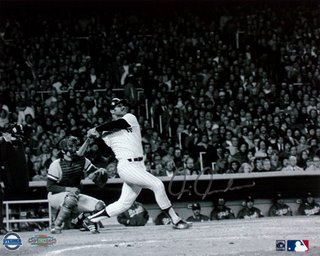 After leading the Yankee hit parade from 1996-2000, Chambliss found himself a man without a job. Gary Denbo was in, and he was in search of work. At first, he was a minor league hitting instructor with the Marlins organization. An interesting interview with Baseball Prospectus details Chambliss' life after the Yankees. As the Enquirer article points out, Chambliss was with the Mets for 3 seasons before being brought aboard in Cincy to rebuild the Big Red Machine. After all, he got a good look at the original Sparky Anderson group in the 1976 Series after vaulting the Yankees there with an ALCS winning walk-off homer in decisive Game 5.
After leading the Yankee hit parade from 1996-2000, Chambliss found himself a man without a job. Gary Denbo was in, and he was in search of work. At first, he was a minor league hitting instructor with the Marlins organization. An interesting interview with Baseball Prospectus details Chambliss' life after the Yankees. As the Enquirer article points out, Chambliss was with the Mets for 3 seasons before being brought aboard in Cincy to rebuild the Big Red Machine. After all, he got a good look at the original Sparky Anderson group in the 1976 Series after vaulting the Yankees there with an ALCS winning walk-off homer in decisive Game 5.
Chambliss was drafted in the 1967 and 1968 amateur draft by the Reds, but opted to continue his education at UCLA instead of signing. He later was drafted by the Indians, won the AL Rookie of the Year in 1971, and then was traded several seasons later with Dick Tidrow and Cecil Upshaw to the Yankees for Fritz Peterson, Steve Kline, Fred Beene, and Tom Buskey. The rest is history for the former Yankee first baseman. Now he's come full circle. I wish him the best of luck with his new team, and we'll see if the streak of excellent hitting can continue for the young Reds.
Sunday, April 30, 2006
The Chambliss Effect
Saturday, April 29, 2006
Matsuzaka Watch: Episode 5

 Daisuke Matsuzaka's 5th start of the year was an off night, in which the star hurler gave up 4 runs on 6 hits, including 3 doubles and a home run. The damage came in only 4.1 innings of work, so the upside to the poor outing is the low pitch count, at 67.
Daisuke Matsuzaka's 5th start of the year was an off night, in which the star hurler gave up 4 runs on 6 hits, including 3 doubles and a home run. The damage came in only 4.1 innings of work, so the upside to the poor outing is the low pitch count, at 67.
The Orix Buffaloes have been just awful this season, and should be thankful that the Rakuten Golden Eagles are in the Pacific League or they would be firmly in the basement in the standings and in every major statistical category on earth. The early success they had against Matsuzaka included a first inning 2-run shot off the bat of failed Major Leaguer and former Dodger, Norihiro Nakamura. It wasn't to last, however, as Seibu's bats came alive in the 7th inning to put up a 5 spot and seal a victory for the first place club. Matsuzaka stayed out of the loss column thanks to a 7th inning, pinch hit, grand slam by superstar Alex Cabrera. Other home runs for Seibu included a 2nd inning shot by third baseman Takeya Nakamura, and a 3rd inning blast by G.G. Sato.
Matsuzaka stayed out of the loss column thanks to a 7th inning, pinch hit, grand slam by superstar Alex Cabrera. Other home runs for Seibu included a 2nd inning shot by third baseman Takeya Nakamura, and a 3rd inning blast by G.G. Sato.
Let's see how young Daisuke rebounds in his next outing in about a week. Here's his updated line on the season: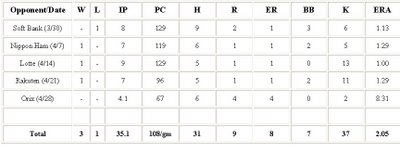
Friday, April 28, 2006
Steve Howe: Rest in Peace
I've been busy the last few days, so I haven't written as much as I'd have liked. The win against Tampa that Matsui and Rivera helped engineer put to bed my post from the day before, and the unfortunate but not unexpected loss to Roy Halladay and the Blue Jays today were on my radar.
Likewise, the playoffs in the Cuban league are off to the races and Sancti Spiritus has battled with La Habana in a gritty first round series. I'll get to that one in good time. What I want to do today is pay my respects to a man who saw more than his fair share of troubles during his life, Steve Howe. The sad story of Steve Howe can be summed up rather easily. A talented pitcher that showcased his arm during Major League service with the Dodgers, Twins, Rangers, and Yankees fought substance abuse problems and was forced to endure some time in the independent leagues and even in Mexico. In and out of the Majors on 7 occasions, Howe was forced to ultimately give up baseball and try for a normal life with his family. It was something that eluded him in the end, as alcohol problems led to one near fatal car accident, and the ultimate accident that took his life today.
The sad story of Steve Howe can be summed up rather easily. A talented pitcher that showcased his arm during Major League service with the Dodgers, Twins, Rangers, and Yankees fought substance abuse problems and was forced to endure some time in the independent leagues and even in Mexico. In and out of the Majors on 7 occasions, Howe was forced to ultimately give up baseball and try for a normal life with his family. It was something that eluded him in the end, as alcohol problems led to one near fatal car accident, and the ultimate accident that took his life today.
I like the picture at left because it says something about the man and his struggles. People in baseball were always willing to stand by him during challenging times, as Joe Girardi is in this shot, but the cold was too much to bear in the end and we are all saddened as the pitcher and the man take their last walk off the field into the arms of angels. I hope he finds peace in the next world.
Steve Howe, 48, is survived by his wife and two children. May he rest in peace.
Wednesday, April 26, 2006
Destroy All Monsters
 Just as I chronicled the success of two resurgent Yankees in my last post, we need to examine the struggles of two other Yankees in this edition. Mussina and Giambi’s rise to glory in April of 2006 coincides with an unfortunate skid for both Hideki Matsui and Mariano Rivera, which is most uncharacteristic of both men, as well as poorly timed.
Just as I chronicled the success of two resurgent Yankees in my last post, we need to examine the struggles of two other Yankees in this edition. Mussina and Giambi’s rise to glory in April of 2006 coincides with an unfortunate skid for both Hideki Matsui and Mariano Rivera, which is most uncharacteristic of both men, as well as poorly timed.
As Mo is our Hall of Fame closer, I’ll save him for the end of this piece and allow him a chance to finish something off cleanly today. Let’s begin with Gojira. Matsui is struggling mightily. There’s no doubt about it and there’s nothing minor about it either. When the Beast from the East gets cold, he gets REAL cold. What are we talking about when we say “REAL cold”? Let’s look at Matsui’s line since the 11th of April in Kansas City.
In the 14 games from April 11th through the 26th, Hideki Matsui has hit 9 for 49, a .184 clip. He has walked 6 times to raise his OBP to a whopping .273, and his SLG is a dismal .245 during the stretch. Simple math tells us that the Japanese star is filling the 6th spot in the Yankee order with a .518 OPS over four and a half series. Hardly the numbers we expect from Matsui at this point in his Yankee career.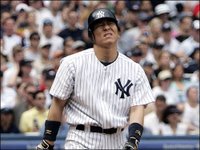 You can read the frustration on his face after each at bat, and it’s apparent he’s pressing. The problem is, he recently played in his 500th consecutive Major League game which got huge press over here in Japan. Why it’s important is a mystery to me. I know his combined streak of games played is tremendous, at almost 1800 games. I know the Japanese recently celebrated Hanshin Tigers outfielder Tomoaki Kanemoto’s 904th consecutive game without an inning missed. What I can’t figure out is why that’s a praiseworthy accomplishment. It, frankly, seems absurd and unfortunate to me. Take a rest.
You can read the frustration on his face after each at bat, and it’s apparent he’s pressing. The problem is, he recently played in his 500th consecutive Major League game which got huge press over here in Japan. Why it’s important is a mystery to me. I know his combined streak of games played is tremendous, at almost 1800 games. I know the Japanese recently celebrated Hanshin Tigers outfielder Tomoaki Kanemoto’s 904th consecutive game without an inning missed. What I can’t figure out is why that’s a praiseworthy accomplishment. It, frankly, seems absurd and unfortunate to me. Take a rest.
To the Japanese, the ideal of never missing a second of work is very real. Your allegiance to the collective is the greatest gift you can give society, and there is absolutely nothing more valued in Japan than that. Matsui’s streak has taken on a symbolic importance to the international image of Japan. Torre is in the tough position of being obligated to play Matsui in some way, shape, or form every game. Matsui will never ask out, so it’s on Joe to put his head on the international chopping block. I know he and Matsui both feel that the slugger will hit his way out of it, particularly with the short porch in right, but one has to wonder if Gojira could use a break from looming over Gotham for a day or two.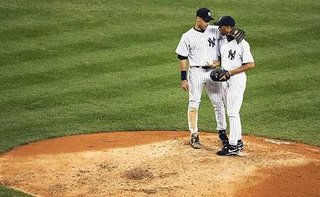 Mariano Rivera’s woes are more illusion than reality, but they are there nonetheless. It’s the perspective we choose to take on Rivera’s performance this year that determine’s our reaction. To me, it’s not news. We’ve seen Mo struggle a bit early in seasons of late, and while he’s blown a couple of games this season, none of them have been to Boston. We all remember the red flags that went up over the entirety of Yankeedom when Mo blew a couple of early season saves to Ortiz and the Sox. This year’s losses to Minnesota and Tampa have been disappointing, but I think everyone knows that they are blips on the radar.
Mariano Rivera’s woes are more illusion than reality, but they are there nonetheless. It’s the perspective we choose to take on Rivera’s performance this year that determine’s our reaction. To me, it’s not news. We’ve seen Mo struggle a bit early in seasons of late, and while he’s blown a couple of games this season, none of them have been to Boston. We all remember the red flags that went up over the entirety of Yankeedom when Mo blew a couple of early season saves to Ortiz and the Sox. This year’s losses to Minnesota and Tampa have been disappointing, but I think everyone knows that they are blips on the radar.
The larger issue to me, is that Mariano has been sitting in the bullpen for the entire month of April without a significant moment of heroics to point to. The Yankees offense has been so awesome in game we’ve won, that his majesty could rest comfortably on his throne. At some point this season, Mo will be needed 4 or 5 times in the span of a week. All of this will change and the ship will be righted. At the moment, a strange set of circumstances has left the King of All Closers a bit rusty and out of rhythm. Have no fear Yankee fans, the Sandman will be putting heads to bed sooner than you know it, and the more he gets against Boston in May, the better.
Rocky and Bullwinkle
 What can you say about Mike Mussina? Now, he’s one of those pitchers who is always referred to in terms of his age, as much as his ability. You know what I’m talking about. Anytime a story is written about Moose, it begins “37-year old Mike Mussina….”
What can you say about Mike Mussina? Now, he’s one of those pitchers who is always referred to in terms of his age, as much as his ability. You know what I’m talking about. Anytime a story is written about Moose, it begins “37-year old Mike Mussina….”
Like his fellow baseball senior citizens Curt Schilling, Randy Johnson, and Greg Maddux, Mussina has learned to keep hitters off balance with a little different approach. Maddux has always been a control pitcher that painted the corners brilliantly, but the others used a mix of off speed stuff with blistering heat in their salad days. As father time encroaches on these pitchers’ careers they are adapting and succeeding. What does it tell us?
It tells us that pitching is not about your live arm, or your leg drive, or your tough looks. Pitching is about keeping batters off balance, and you do that by outthinking them. You do that by employing superior control and technique. If you can also throw it by a guy, you go to the Hall of Fame. Mussina has always been able to control his pitches. He’s always been able to outthink the opposition, his Stanford education being a favorite topic among YES announcers. Moose has employed outstanding technique in mastering a number of pitches, including his time tested “nose to toes” curve ball.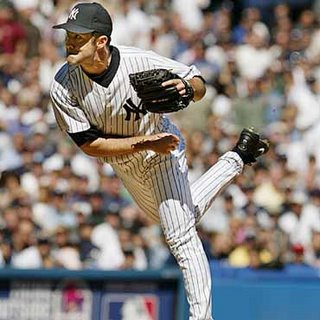 What’s different this year is Mussina’s willingness to forgo the days of the power fastball, in favor of the slow-slower-slowest approach that has kept guys like Jamie Moyer in baseball beyond the age of 40. Mussina still has the stuff he needs to dominate on any given night, but he’s used his noodle to adjust to the cards that his body has dealt him at 37. The curveball still bites. The fastball still has some pop when he needs it, but whatever he throws, he’s sure that it is going to keep his opponent off balance. That’s the key. David Cone knew it. Maddux knows it. Even Roger Clemens, with his fastball still at its thunderous best, knows it…hence the sub-2.00 ERA last year and the $10 million contract waiting for him for a half season, plus playoffs.
What’s different this year is Mussina’s willingness to forgo the days of the power fastball, in favor of the slow-slower-slowest approach that has kept guys like Jamie Moyer in baseball beyond the age of 40. Mussina still has the stuff he needs to dominate on any given night, but he’s used his noodle to adjust to the cards that his body has dealt him at 37. The curveball still bites. The fastball still has some pop when he needs it, but whatever he throws, he’s sure that it is going to keep his opponent off balance. That’s the key. David Cone knew it. Maddux knows it. Even Roger Clemens, with his fastball still at its thunderous best, knows it…hence the sub-2.00 ERA last year and the $10 million contract waiting for him for a half season, plus playoffs.
Eventually, Mussina will have a rocky start, but to this point he has opened the season with five consecutive quality starts and an ERA at 2.46 on the year. We haven’t seen a stretch of consistent brilliance like this from Moose for some time, and it bodes well for Yankee hopes on the season if he can continue to fool batters the way he has so far. Today’s performance was a model of his wisdom and competitive edge, as he dominated the Devil Rays over 6 innings of baseball, the Yankees winning 9-1. I hope the guys behind him in the rotation are watching and learning, for where their talent can’t take them, perhaps their approach will win out.
The other side of the winning equation for the Yankees on Tuesday was the resurgent Jason Giambi, once again in the DH slot. Giambi isn't referred to in terms of age, but rather allegations. Barry Bonds gets syringes thrown at him, while Giambi only has to endure the jeers and signage that greet him in opposing ballparks.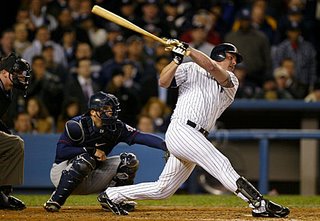 There are those that gave "Giambino" up for dead during the stretch between July 2003 and July of 2005. There are those who decided the Giambi train was derailing and that he had sold his soul by succumbing to temptation along with other prominent figures of the late-90's. Giambi probably even lost faith at some point along the way. The thing is, performance enhancing drugs give you an edge in building muscle. They give you an edge in recovering from hard labor. Performance enhancing drugs have never given players the ability to see the ball better, or time their swing perfectly. They have never been credited with making a ballplayer out of a hack. Giambi has never been a hack.
There are those that gave "Giambino" up for dead during the stretch between July 2003 and July of 2005. There are those who decided the Giambi train was derailing and that he had sold his soul by succumbing to temptation along with other prominent figures of the late-90's. Giambi probably even lost faith at some point along the way. The thing is, performance enhancing drugs give you an edge in building muscle. They give you an edge in recovering from hard labor. Performance enhancing drugs have never given players the ability to see the ball better, or time their swing perfectly. They have never been credited with making a ballplayer out of a hack. Giambi has never been a hack.
After July 4th of last season, Giambi hit 27 home runs in 230 at bats, which amounts to one in every 8.5 times up. In the time between July 2003 and July 2005, Giambi hit 36 home runs in 709 at bats, which is a home run every 19.7 times up. What's more, the power wasn't the big problem. Before the 2003 season, the lowest batting average Giambi had ever produced in the Big Leagues was .291 during his first full year. He had become the AL MVP by hitting at a .300+ clip while walking more than Steven Tyler. During his worst stretch, Giambi lost the Hall of Fame home run stroke and managed a .227 average to boot.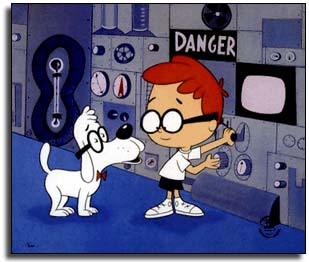 This year, we are seeing the Oakland Giambi that we paid for several years ago. Not only has he added 7 home runs to the 27 he hit after Independence Day last year, but he's also hitting .347 in April. Including his hot streak to end last season he is now hitting .298(83/279) to go with his 34 home runs. Let's hope he keeps it up and removes the doubt that some of us built in our minds about the remaining career of this true Rocky. Myself included.
This year, we are seeing the Oakland Giambi that we paid for several years ago. Not only has he added 7 home runs to the 27 he hit after Independence Day last year, but he's also hitting .347 in April. Including his hot streak to end last season he is now hitting .298(83/279) to go with his 34 home runs. Let's hope he keeps it up and removes the doubt that some of us built in our minds about the remaining career of this true Rocky. Myself included.
Now if only we could get Mr. Peabody and Sherman to turn back the clock on Bernie...
Monday, April 24, 2006
Gourriel Watch: A Season for the Ages
 The 45th National Season has concluded and the MVP is all but a sure thing for Yulieski Gourriel. The young man has led his Sancti Spiritus Gallos to the Group B title, winning the final 29 of 31 games, including 25 consecutive victories. Gourriel homered in 5 of the last 6 games, including the last 4 in a row. His 57 extra base hits broke the single season record by a wide margin, and he became the first player in Cuban history to go 20/20. Did I mention that he's only 22 years old?
The 45th National Season has concluded and the MVP is all but a sure thing for Yulieski Gourriel. The young man has led his Sancti Spiritus Gallos to the Group B title, winning the final 29 of 31 games, including 25 consecutive victories. Gourriel homered in 5 of the last 6 games, including the last 4 in a row. His 57 extra base hits broke the single season record by a wide margin, and he became the first player in Cuban history to go 20/20. Did I mention that he's only 22 years old? Gourriel appears on the leaderboard of virtually every important offensive statistic, and is notable for the following statistical accomplishments this season:
Gourriel appears on the leaderboard of virtually every important offensive statistic, and is notable for the following statistical accomplishments this season:
Runs - 1st (89)
Triples - 1st (11)
Home Runs - 1st (27)
RBIs - 1st (92)
Total Bases - 1st (236)
Stolen Bases - 2nd (21)
Slugging % - 3rd (.676)
Remember, the Cuban season is only 90 games long, so we need to look at his numbers as they are and pro-rated to a 162 game season to put them into proper perspective. Click below to view his 90 game stats: One further note on the numbers you see above. Gourriel added a .484 OBP to his .676 slugging, for an OPS of 1.160. That is virtually the identical figure that Babe Ruth put up for his career, and matches the single season numbers for Ted Williams in 1946, and Todd Helton in 2000. Let's look at the pro-rated 162 game stats(click below):
One further note on the numbers you see above. Gourriel added a .484 OBP to his .676 slugging, for an OPS of 1.160. That is virtually the identical figure that Babe Ruth put up for his career, and matches the single season numbers for Ted Williams in 1946, and Todd Helton in 2000. Let's look at the pro-rated 162 game stats(click below):
 Setting a 160 run, 166 RBI pace is insane. Put that together with 20 triples and 49 home runs, and you have something resembling Lou Gehrig's 1931 season. 38 stolen bases on top of all that is unheard of. To put it in perspective, Gourriel would account for 446 total bases, good for 4th place on the all-time single season list behind Ruth (1921), Hornsby (1922), and Gehrig (1927). It's best if we just leave it at that. At 22 years old, Yulieski Gourriel has just set the equivalent of a Joe Dimaggio, Babe Ruth, Lou Gehrig mark in the Cuban ranks. It's been a pleasure to follow, and I look forward to seeing what he can do in the upcoming playoffs.
Setting a 160 run, 166 RBI pace is insane. Put that together with 20 triples and 49 home runs, and you have something resembling Lou Gehrig's 1931 season. 38 stolen bases on top of all that is unheard of. To put it in perspective, Gourriel would account for 446 total bases, good for 4th place on the all-time single season list behind Ruth (1921), Hornsby (1922), and Gehrig (1927). It's best if we just leave it at that. At 22 years old, Yulieski Gourriel has just set the equivalent of a Joe Dimaggio, Babe Ruth, Lou Gehrig mark in the Cuban ranks. It's been a pleasure to follow, and I look forward to seeing what he can do in the upcoming playoffs.
Saturday, April 22, 2006
Yankee Notes: April 22, 2006
 A few things struck me about the middle game of the Yankees/Orioles series at the Stadium. On a chilly, rainy afternoon in New York the Yankees engaged in a generally listful and slow moving ball game against Baltimore, coming out on top by the score of 6-1.
A few things struck me about the middle game of the Yankees/Orioles series at the Stadium. On a chilly, rainy afternoon in New York the Yankees engaged in a generally listful and slow moving ball game against Baltimore, coming out on top by the score of 6-1.
The first point of interest was the turn of fortune for embattled pitcher Shawn Chacon, who gave up a single run over 7 innings, earning the only quality start of the young season for a Yankee pitcher not named "Randy" or "Mike". It took 16 games before the Yankees found a successful formula for a player at the back end of the rotation, but it came at an opportune time, with the aforementioned "Unit" and his ace partner Mike Mussina coming up next for the Bombers. It appears as though there is some light at the end of the tunnel for a good homestand. The second note if interest was Hideki Matsui's two run double in the bottom of the 6th. With the bases loaded this season, the Yankees had only been able to muster 3 hits, all in the opening game in Anaheim. Matsui has struggled over the last 2 weeks, going 5-29 combined in series versus Kansas City, Minnesota, and Toronto. He is now 3-7 with two doubles, 3 runs, and 2 RBIs in two games against the Orioles. With the short porch in right staring him in the face, I expect to see a couple of home runs for Gojira during this homestand, and a strong close to the month of April.
The second note if interest was Hideki Matsui's two run double in the bottom of the 6th. With the bases loaded this season, the Yankees had only been able to muster 3 hits, all in the opening game in Anaheim. Matsui has struggled over the last 2 weeks, going 5-29 combined in series versus Kansas City, Minnesota, and Toronto. He is now 3-7 with two doubles, 3 runs, and 2 RBIs in two games against the Orioles. With the short porch in right staring him in the face, I expect to see a couple of home runs for Gojira during this homestand, and a strong close to the month of April.
The other note of interest to me was the ridiculous use of the sacrifice bunt by both teams, early in the ballgame. I took some time to defend the sacrifice in the series against Minnesota, going against the grain, and against my own personal feeling about the strategy. In that case, with Mariano Rivera on the mound, Damon on second with no outs, and Jeter at the plate, I though it was fair strategy to play for one and give the Sandman a little pillow to put the Twins to sleep. In today's ballgame, I thought all three sacrifice situations were strictly idiotic and I'd like to quickly run down the plays to show why. 1. In the top of the 3rd inning, Baltimore put runners on 1st and 2nd with no one out thanks to back to back walks by Shawn Chacon. The Yankees held a 2-0 lead, but the Birds appeared to have Chacon in a bit of trouble with Mora and Tejada coming up. To my astonishment, Mora, a career .284 hitter with Baltimore, gave himself up to move the tying run into scoring position for Tejada. It seems to me that his skill with the bat should allow him to push a ball to the right side and move the runners over swinging away. With Chacon on the ropes a bit, he may get a hit. At the very least he may force a few more pitches out of his arm and perhaps even draw another walk to load the bases. According to this trusty chart, the bunt they opted for in that situation actually contributes a -6.7% chance to an Orioles victory. Tejada grounded out weakly to the pitcher and Gibbons popped out to short. No runs, and one wasted out.
1. In the top of the 3rd inning, Baltimore put runners on 1st and 2nd with no one out thanks to back to back walks by Shawn Chacon. The Yankees held a 2-0 lead, but the Birds appeared to have Chacon in a bit of trouble with Mora and Tejada coming up. To my astonishment, Mora, a career .284 hitter with Baltimore, gave himself up to move the tying run into scoring position for Tejada. It seems to me that his skill with the bat should allow him to push a ball to the right side and move the runners over swinging away. With Chacon on the ropes a bit, he may get a hit. At the very least he may force a few more pitches out of his arm and perhaps even draw another walk to load the bases. According to this trusty chart, the bunt they opted for in that situation actually contributes a -6.7% chance to an Orioles victory. Tejada grounded out weakly to the pitcher and Gibbons popped out to short. No runs, and one wasted out.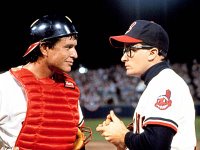 2. The Yankees were the village idiots in the bottom of the 3rd. After Robinson Cano drew his FIRST WALK OF THE SEASON against control-challenged Daniel Cabrera, Kelly Stinnett chose to give up his bat to move Cano to second with a two run lead, early in the game. At this point, I turned to my wife and gasped out, "What am I watching here? Did I actually see two sac bunts in the 3rd inning?" She declined to respond. Cabrera had just walked free-swinging Cano on four pitches and had already issued 17 walks in his previous 3 starts, but with a 2-0 count we offer him an easy way out. Damon struck out following the bunt, and Jeter successfully drove in the run from second. The strategy payed off, in that the Yankees got their run, but it struck me a bit like watching Matlock drive an Indy car.
2. The Yankees were the village idiots in the bottom of the 3rd. After Robinson Cano drew his FIRST WALK OF THE SEASON against control-challenged Daniel Cabrera, Kelly Stinnett chose to give up his bat to move Cano to second with a two run lead, early in the game. At this point, I turned to my wife and gasped out, "What am I watching here? Did I actually see two sac bunts in the 3rd inning?" She declined to respond. Cabrera had just walked free-swinging Cano on four pitches and had already issued 17 walks in his previous 3 starts, but with a 2-0 count we offer him an easy way out. Damon struck out following the bunt, and Jeter successfully drove in the run from second. The strategy payed off, in that the Yankees got their run, but it struck me a bit like watching Matlock drive an Indy car. 3. Nauseatingly, the team once managed brilliantly by Earl Weaver chose to sacrifice again in the 5th inning. With runners on 1st and 2nd and no outs, Nick Markakis was asked to sacrifice his teammates into scoring position for Mora and Tejada. Having failed two innings earlier, you'd think the Orioles would have the young man swing away and try to drive in a run. The rookie sports a low batting average, but has shown a patient eye at the plate if nothing else. True to form, the bunt went straight to Chacon, who threw to third nailing the lead runner. He may as well have struck out. The aforementioned chart, indicates that a bunt in that situation contributes a -3.8% chance to a Baltimore victory.
3. Nauseatingly, the team once managed brilliantly by Earl Weaver chose to sacrifice again in the 5th inning. With runners on 1st and 2nd and no outs, Nick Markakis was asked to sacrifice his teammates into scoring position for Mora and Tejada. Having failed two innings earlier, you'd think the Orioles would have the young man swing away and try to drive in a run. The rookie sports a low batting average, but has shown a patient eye at the plate if nothing else. True to form, the bunt went straight to Chacon, who threw to third nailing the lead runner. He may as well have struck out. The aforementioned chart, indicates that a bunt in that situation contributes a -3.8% chance to a Baltimore victory.
The Orioles only scratched one run out against the regularly shaky Shawn Chacon and probably gave him two gift outs at the moments when he looked most vulnerable to big rallies. Of the three bunts offered today, only one run was manufactured, while three outs were given away. When the team who bunted twice loses by 5 runs, you have to scratch your head. I hope we see more of the same from Baltimore against Randy Johnson tomorrow.
[Correction: Chien Ming Wang posted a quality game on 4/16 against Minnesota.]
Los Gallos Win the Pennant!!!
 Okay, so it took me two times to get it right.....the Gallos of Sancti Spiritus have finally put Group B to bed on the second to last day of the regular season. Industriales' pitcher Frank Montieth uncorked a wild pitch with a runner on third in the bottom of the ninth, dealing a crushing 6-5 defeat to his club at the hands of La Habana, and leaving the door open for Lourdes Gourriel's club to win and take home the division crown.
Okay, so it took me two times to get it right.....the Gallos of Sancti Spiritus have finally put Group B to bed on the second to last day of the regular season. Industriales' pitcher Frank Montieth uncorked a wild pitch with a runner on third in the bottom of the ninth, dealing a crushing 6-5 defeat to his club at the hands of La Habana, and leaving the door open for Lourdes Gourriel's club to win and take home the division crown.
It was up to outstanding Gallos' starter Ramon Licor to bring home the win for Sancti Spiritus and the pennant. Licor delivered beautifully with 8 innings of 1 run baseball. He scattered 6 hits and 3 walks, while striking out 4, before handing the ball to Danny Perez for a 1-2-3 inning in the ninth and a convincing 10-1 victory. There were several hitting stars in the ballgame, as you might imagine with a score in double digits, but we can again point to the heroics of catcher Eriel Sanchez(at left) who went 1-4 with a home run and 2 RBIs, and soon-to-be MVP Yulieski Gourriel who was 2-4 with a home run(26) and a triple(11) and 3 runs batted in.
The final game of the season is a moot point for Sancti Spiritus and we will recap with an eye on the playoffs just ahead when we post tomorrow. A more comprehensive look at Yulieski Gourriel's complete season will be featured shortly in a "Gourriel Watch" special feature.
Sancti Spiritus Looks to Hang On
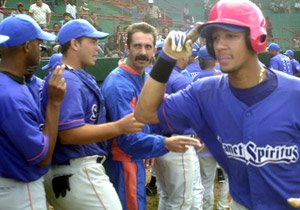 Some time ago I reported that the streaking Gallos had guaranteed themselves 1st place in Group B. In retrospect, my Spanish being as rusty as it is, I was mistaken. The Gallos in fact had vaulted Industriales into 1st and guaranteed themselves a spot in the playoffs as one of the final 8 teams to compete in the post season.
Some time ago I reported that the streaking Gallos had guaranteed themselves 1st place in Group B. In retrospect, my Spanish being as rusty as it is, I was mistaken. The Gallos in fact had vaulted Industriales into 1st and guaranteed themselves a spot in the playoffs as one of the final 8 teams to compete in the post season.
Industriales lives! Only a game behind Sancti Spiritus after taking two of three on their home field, Industriales put up a 9-1 victory over La Habana to pull within a half game of first. What would Sancti do in their own opener against Cienfuegos. Could they hold pace with Industriales with 3 games remaining in the season and a division lead? On this day, the answer was "yes".
Thanks to a home run(25) and a triple(10) by Yulieski Gourriel, the Gallos walked away 9-5 with their one game advantage intact with two to play. Reinier Yero, who had provided Sancti with 5 RBIs in their lone win at Industriales several days ago, went 4-4. What will tomorrow bring?
Friday, April 21, 2006
Matsuzaka Watch: Episode 4

 A chilly evening in Sendai, Japan greeted Daisuke Matsuzaka and his Seibu Lions on April 21st. A reported crowd of 5,486 lonely souls braved the miserable weather to cheer on their 2nd year expansion Rakuten Golden Eagles. I have to believe that many of those fans were either clinically insane, or like-minded fans of the crown jewel of Japanese Professional Baseball. Perhaps they were both. They saw a Seibu victory over the home team 11-1.
A chilly evening in Sendai, Japan greeted Daisuke Matsuzaka and his Seibu Lions on April 21st. A reported crowd of 5,486 lonely souls braved the miserable weather to cheer on their 2nd year expansion Rakuten Golden Eagles. I have to believe that many of those fans were either clinically insane, or like-minded fans of the crown jewel of Japanese Professional Baseball. Perhaps they were both. They saw a Seibu victory over the home team 11-1.
As usual Matsuzaka dominated the opposition, giving up 5 hits and a single run over 7 innings of work using only 96 pitches to get the job done. His fastball was clocked between 96-97 mph throughout the game helping him tally 11 strikeouts in baffling the hapless Golden Eagles. Matsuzaka got all the offense he needed in a 9 run second inning capped by outstanding and follically challenged outfielder Kazuhiro Wada's grand slam. Seibu leads the Pacific League by 2 games with a 14-7 record, and looks to continue their surge behind good hitting and excellent pitching. For Matsuzaka's current pitching line click below:
Seibu leads the Pacific League by 2 games with a 14-7 record, and looks to continue their surge behind good hitting and excellent pitching. For Matsuzaka's current pitching line click below:
Thursday, April 20, 2006
Gallos Estan Finito
 And so comes an end to an amazing streak of 25 consecutive victories for the Gallos of Sancti Spiritus. The fateful game took place several days ago at Stadio Latinoamericano, but access to the Federation of Cuban Baseball's website was not possible for some reason and I only confirmed the news today. For two days I searched the internet for an alternative source, finding my efforts frustrated at each turn. The Sancti Spiritus online newspaper "Escambray" featured a blurb about the defeat, but offered nothing in the way of details. Actually, I hoped that my Spanish was simply insufficient for the headline and that the streak was somehow still alive, but it was not.
And so comes an end to an amazing streak of 25 consecutive victories for the Gallos of Sancti Spiritus. The fateful game took place several days ago at Stadio Latinoamericano, but access to the Federation of Cuban Baseball's website was not possible for some reason and I only confirmed the news today. For two days I searched the internet for an alternative source, finding my efforts frustrated at each turn. The Sancti Spiritus online newspaper "Escambray" featured a blurb about the defeat, but offered nothing in the way of details. Actually, I hoped that my Spanish was simply insufficient for the headline and that the streak was somehow still alive, but it was not.
After a day off, the Gallos began their series against Industriales, the team that they had recently skyrocketed past into first place in Group B. This rivalry has a long and vibrant history and amounts to our own battle with the Red Sox. It was fate that the two teams would meet with only days remaining in the season, Sancti Spiritus looking to make history. Perhaps it was also only fitting that Industriales was the club to deny the Gallos an opportunity to tie the all time record of 26 consecutive victories and certainly they did not want to be the victims of a record breaking 27th. Industriales is a strong team that led Group B for most of the 45th National Season. Overcome by the streaking Gallos, they have settled for what amounts to the Wild Card in the Cuban West. They feature WBC Cuban National Ace Yadel Marti and top shelf slugger Yoandry Urgelles, among other outstanding players. It was the combination of these two heroes that proved too much for Sancti Spritus in the end.
Industriales is a strong team that led Group B for most of the 45th National Season. Overcome by the streaking Gallos, they have settled for what amounts to the Wild Card in the Cuban West. They feature WBC Cuban National Ace Yadel Marti and top shelf slugger Yoandry Urgelles, among other outstanding players. It was the combination of these two heroes that proved too much for Sancti Spritus in the end.
Marti is a great talent. He dominated the WBC, and paired with Cuba's top pitcher Pedro Luis Lazo of Pinar del Rio for the semi-final victory over the star-studded Dominican lineup. Marti posted an impressive line against Sancti Spriritus in the overwhelming 11-1 victory, throwing 7 innings of 2 hit ball, with no walks and 7 strikeouts. The only run came off the bat of Yulieski Gourriel, hammering his league leading 24th home run on the year in the top of the 4th inning. The game was called after the visitor's 7th inning, rather unceremoniously by mercy rule. I would have liked to have seen the Gallos get their final 2 innings to keep the dream alive, but rules are rules. In the days since the streak was broken, the series has continued with the season waning and the playoffs just on the horizon. The teams split the following contests, with Sancti Spiritus claiming victory 8-3 on Reinier Yero's 5 RBI night in Game 2 before falling again to their rivals 9-8 after mounting a furious 4 run 9th inning rally that came up one short of tying the score. Perhaps we'll be lucky enough to see some fireworks from these clubs again in the games that really count.
In the days since the streak was broken, the series has continued with the season waning and the playoffs just on the horizon. The teams split the following contests, with Sancti Spiritus claiming victory 8-3 on Reinier Yero's 5 RBI night in Game 2 before falling again to their rivals 9-8 after mounting a furious 4 run 9th inning rally that came up one short of tying the score. Perhaps we'll be lucky enough to see some fireworks from these clubs again in the games that really count.
A note on Yulieski Gourriel. The young man is a run away favorite for MVP, and became the first player in the history of Federation Baseball to 20 or more home runs(24) and steal 20 or more bases(21). Keep in mind that his 20-20 season was accomplished in 86 games, amounting to little more than half of a Major League season. He broke the record for extra base hits in a season (50 and counting) and sits second in RBIs on the year(82) while batting .321. What will he do for an encore?
Wednesday, April 19, 2006
Ace of Moose
 Just when the Not-So Big Unit flashed his trademark Yankee inconsistency, the steady pitching of Mike Mussina has come to the rescue. Mussina has been brilliant this season, despite not always getting the run support to pick up the victory. It appears as though he's in for a very nice season with April getting a little wind behind his sails. It's been a while since we've seen this kind of consistent excellence from Moose to start the season, but the stoic Pennsylvanian is leading the way out of the darkness for the Yankees in this early season funk.
Just when the Not-So Big Unit flashed his trademark Yankee inconsistency, the steady pitching of Mike Mussina has come to the rescue. Mussina has been brilliant this season, despite not always getting the run support to pick up the victory. It appears as though he's in for a very nice season with April getting a little wind behind his sails. It's been a while since we've seen this kind of consistent excellence from Moose to start the season, but the stoic Pennsylvanian is leading the way out of the darkness for the Yankees in this early season funk.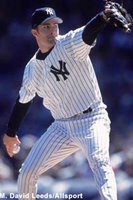 In the last 2 years, Moose put up a poor record in April, at 2-6, while the Yankees were 2-9 in games started by the right hander. Moose's early struggles have mirrored the Yankee tendency to get out of the blocks slowly of late. His good numbers in May and June coincide with Yankee fortunes picking up, and perhaps his early success this year bodes well for the future. The team roared out of the gates in 2003, if you’ll remember, and posted an impressive 11-3 over their first fourteen games, and went 20-4 overall in April. The story in both 2004 and 2005 was very different and perhaps helps explain the early frustration that Yankee fans are feeling again this season, with the team off to a 7-7 start. There is hope.
In the last 2 years, Moose put up a poor record in April, at 2-6, while the Yankees were 2-9 in games started by the right hander. Moose's early struggles have mirrored the Yankee tendency to get out of the blocks slowly of late. His good numbers in May and June coincide with Yankee fortunes picking up, and perhaps his early success this year bodes well for the future. The team roared out of the gates in 2003, if you’ll remember, and posted an impressive 11-3 over their first fourteen games, and went 20-4 overall in April. The story in both 2004 and 2005 was very different and perhaps helps explain the early frustration that Yankee fans are feeling again this season, with the team off to a 7-7 start. There is hope.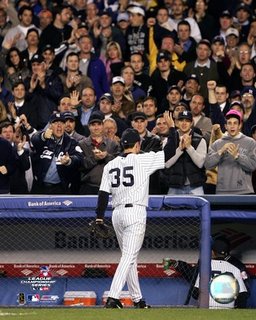 The Bombers posted a 5-9 record over 14 last season, and a 7-7 in 2004. The team finished April 10-14 in 2005, and 13-11 in 2004. The difference this season, at least in my mind, is that in 2006 Mussina has been excellent. To date, Mike Mussina has started 4 games and has a 2-1 record to show for his efforts. He could be 4-0 quite easily, however, as all four starts have been Quality Starts, and he features a stellar 2.67 ERA and a 1.074 WHIP.
The Bombers posted a 5-9 record over 14 last season, and a 7-7 in 2004. The team finished April 10-14 in 2005, and 13-11 in 2004. The difference this season, at least in my mind, is that in 2006 Mussina has been excellent. To date, Mike Mussina has started 4 games and has a 2-1 record to show for his efforts. He could be 4-0 quite easily, however, as all four starts have been Quality Starts, and he features a stellar 2.67 ERA and a 1.074 WHIP.
The back of our rotation is worrisome, but a good Moose in 2006 is a departure from the guy who posted only 2 Quality Starts out of 5 last April, and went 0-6 in 2004. Randy Johnson will be good over the long haul and while we’ll have to put up with some creaky knees and apparently a “dead arm period” every so often, I’m not so worried about him. The combination of those two solid pitchers at the front of the rotation should give the team some momentum in turning our Spring cobwebs into Summer silk.
Tuesday, April 18, 2006
Yankee Spin
 I'm a student of semantics. My particular area of interest is media and propaganda. I can't claim to be an expert but I certainly have put in hours and hours of study and reading on the subject. With regard to the Yankees organizational use of "spin", I'd like to borrow an old Supreme Court line from Justice Potter Stewart, "I can't define Yankee horse$&*!, but I know it when I see it."
I'm a student of semantics. My particular area of interest is media and propaganda. I can't claim to be an expert but I certainly have put in hours and hours of study and reading on the subject. With regard to the Yankees organizational use of "spin", I'd like to borrow an old Supreme Court line from Justice Potter Stewart, "I can't define Yankee horse$&*!, but I know it when I see it."
Don't get me wrong, I understand that there's a delicate line that professional sports organizations have to walk to appease their high priced, and frequently tempermental, stars. There's also a fine line to be walked in managing fans expectations and disappointment when things aren't hunky dory. The manager must play psychologist when making public statements after a game's conclusion, and team spokespeople must also choose their words carefully when addressing the media after a loss. The Yankees are masterful in their ballet of BS.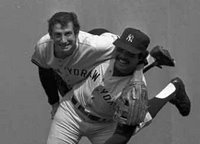 During the era of the Bronx Zoo, the Yankee players, managers, and organization practiced very little restraint when commenting in front of reporters. Famous quotes flew left and right and some of the most interesting statements in the team's long history can be found during this entertaining and tumultuous period. I think immediately of Reggie Jackson's "straw that stirs the drink" comment, or Billy Martin's quote on Reggie and The Boss: "The two of them deserve each other. One's a born liar, the other's convicted."
During the era of the Bronx Zoo, the Yankee players, managers, and organization practiced very little restraint when commenting in front of reporters. Famous quotes flew left and right and some of the most interesting statements in the team's long history can be found during this entertaining and tumultuous period. I think immediately of Reggie Jackson's "straw that stirs the drink" comment, or Billy Martin's quote on Reggie and The Boss: "The two of them deserve each other. One's a born liar, the other's convicted." These days, all you get is bland and recycled cliche. Jeter is a master of cliche, and has successfully maintained a steady and controlled image with the New York media. Torre is almost sedate with the press and it has served him well since he arrived to the headline "Clueless Joe". Giambi has been humble and amenable to the press even in the wake of major steroid revelations. Alex Rodriguez said nothing last Spring Training, even while the Red Sox were calling him out as a fraud. Only Gary Sheffield has found his outbursts in print recently. Usually guys who rock the boat find the door. See: Chad Curtis, Raul Mondesi, Ruben Sierra.
These days, all you get is bland and recycled cliche. Jeter is a master of cliche, and has successfully maintained a steady and controlled image with the New York media. Torre is almost sedate with the press and it has served him well since he arrived to the headline "Clueless Joe". Giambi has been humble and amenable to the press even in the wake of major steroid revelations. Alex Rodriguez said nothing last Spring Training, even while the Red Sox were calling him out as a fraud. Only Gary Sheffield has found his outbursts in print recently. Usually guys who rock the boat find the door. See: Chad Curtis, Raul Mondesi, Ruben Sierra. The reason I'm writing this now, is that I'm just a little sick of the Yankee Kool-Aid when it comes to players underperforming. I know that no one is going to say that Randy Johnson is breaking down and may not be able to give the Yankees more than a quality start or two at a time, but the ridiculous excuses that they are asking us to swallow every few weeks are insulting to my intelligence. The latest Johnson apologist is personal caddy to The Big Unit and career roster filler, Kelly Stinnett, who says, "Sometimes (a pitcher goes) through a dead arm period; some days you're going to have it, some days you're not."
The reason I'm writing this now, is that I'm just a little sick of the Yankee Kool-Aid when it comes to players underperforming. I know that no one is going to say that Randy Johnson is breaking down and may not be able to give the Yankees more than a quality start or two at a time, but the ridiculous excuses that they are asking us to swallow every few weeks are insulting to my intelligence. The latest Johnson apologist is personal caddy to The Big Unit and career roster filler, Kelly Stinnett, who says, "Sometimes (a pitcher goes) through a dead arm period; some days you're going to have it, some days you're not."
What?!
I know that the only reason Stinnett has a job with the Yankees is because Johnson is a cranky ass bastard that can't hack a strong catcher telling him what's what. Posada runs the staff and Johnson doesn't want to hear it from the guy crouching in front of him. Johnson's idea of a catcher is a piece of plywood with a hole in it. If you want to paint a face on it, go ahead, but it makes no difference as long as it doesn't talk or try to make any decisions. That being said, you can take the "dead arm period" BS and sell it to someone else. It's not even a month into the season and this guy is our supposed ace. If he has a dead arm now, we'd better start looking for another guy to step in and be the #1 post-haste. Boston has a revived Schilling, and a lights out Beckett, and you know they are looking at Dontrelle Willis and Roger Clemens hoping one of them will join the rotation. If that happens, it's over in the AL East. Whatever excuses you hear about Jaret Wright, Shawn Chacon, Tanyon Sturtze, or Randy Johnson you can bank on the fact that there's a problem that no one is admitting to in public. If you open your eyes and look at the Yankees closely, you'll see things how they are...a Ferrari lineup with a Yugo rotation. There's still time to shape things up, but don't be fooled. Johnson, Mussina, Wang, Chacon, Wright, Pavano, and whoever else they're going to throw our there this year aren't the same level player that we've had pitching big games for us in recent years. The offense is going to have to carry the team, and that's not a formula for success in October when it really matters.
Whatever excuses you hear about Jaret Wright, Shawn Chacon, Tanyon Sturtze, or Randy Johnson you can bank on the fact that there's a problem that no one is admitting to in public. If you open your eyes and look at the Yankees closely, you'll see things how they are...a Ferrari lineup with a Yugo rotation. There's still time to shape things up, but don't be fooled. Johnson, Mussina, Wang, Chacon, Wright, Pavano, and whoever else they're going to throw our there this year aren't the same level player that we've had pitching big games for us in recent years. The offense is going to have to carry the team, and that's not a formula for success in October when it really matters.
What will they try to feed us next? Which player is just pressing now? Who just wants it so bad, and needs to relax and let his game come to him? Read the newspapers everyday and find out. Go ahead.
Sunday, April 16, 2006
Sancti Spiritus' Dramatic 25th!!
In front of a crowd of 10,000 fans at Jose Antonio Huelga Stadium, the Gallos of Sancti Spiritus played a grueling see-saw affair in their finale against Cienfuegos. The game lasted an unmanagable (sorry for the Michael Kay line) 3 hours and 45 minutes, decided in the bottom of the 10th inning in dramatic fashion. Final score: 11-10 Gallos.
Liuber Morales Herrera of Sancti Spiritus started the game against Adiel Palma Lopez. Both pitchers were not on their games and Herrera was knocked out after only one inning. He gave up 2 hits, 2 walks, and was lucky to escape with only two runs allowed. Four Gallos' pitchers followed Herrera and none of them was remotely effective. They posted a WHIP of 2.000 over 10 innings and seemed intent on ending the streak at 24.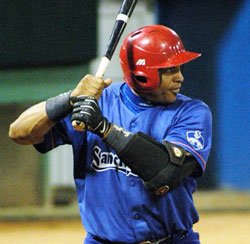 Quite fortunatley for Lourdes Gourriel's club, Lopez was not stellar for Cienfuegos either. He managed to go 7.2 innings, giving up 7 hits, 3 walks, and 6 runs (5 earned). Even so, he handed an 8-6 lead to his relief core after surrendering 3 runs in the home half of the 8th. The excitement was only beginning. Islet Santiago gave up the tying runs in the bottom of the 9th to keep hope alive.
Quite fortunatley for Lourdes Gourriel's club, Lopez was not stellar for Cienfuegos either. He managed to go 7.2 innings, giving up 7 hits, 3 walks, and 6 runs (5 earned). Even so, he handed an 8-6 lead to his relief core after surrendering 3 runs in the home half of the 8th. The excitement was only beginning. Islet Santiago gave up the tying runs in the bottom of the 9th to keep hope alive.
The top of the 10th seemed like Cinderella's midnight bell for the Espirituanos as Cienfuegos put two on the board in the first frame of extra innings. Everyone in the Stadium should have known better. The Gallos are not to be denied and a furious rally against Cienfuegos closer Leovel Cardoso Serpa ended the ballgame in dramatic fashion when Eriel Sanchez blasted a two run shot, his 8th on the season, to seal the victory in walk off style.
Pitching was not the key to this ballgame, bucking the trend of impressive victories in recent days for Sancti Spiritus. It was timely dramatic hitting by Livan Monteagudo and Sanchez that saved the day and allowed the Gallos to fight on against Industriales tomorrow for a crack at #26. Yulieski Gourriel was uncharacteristically absent from the drama and managed to put up an 0-5 amid the scoring outburst. Stay tuned!
Saturday, April 15, 2006
The Art of the Sacrifice
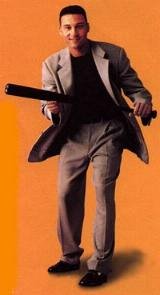 I was prompted to write this piece after an exchange at Bronx Banter regarding Derek Jeter's 9th inning sacrifice bunt with Johnny Damon on 2nd and no one out. The game was 5-4 Yankees and Mariano had induced a double play to end the 8th.
I was prompted to write this piece after an exchange at Bronx Banter regarding Derek Jeter's 9th inning sacrifice bunt with Johnny Damon on 2nd and no one out. The game was 5-4 Yankees and Mariano had induced a double play to end the 8th.
Some would argue that a sac bunt is a wasted out, and that outs are too precious to give up. They would argue that small ball is essentially a way to lose ballgames: see Earl Weaver. Others, still, would argue that a career .315 hitter like Jeter has just as good a chance at poking a ball to the right side swinging away and driving in the run without the sacrifice. Why give up an out?
I would wholeheartedly agree with that notion in an earlier situation. I don't see the point in employing that strategy in the early point of a ballgame, and I think we'd all be insane to think that a ballclub made up of power hitting All Stars should lower themselves to scratching out a run here and there. It would be a waste of talent and potential run production. I would remind those critics of the sacrifice bunt that managers for more than 100 years have recognized the value of a well placed sacrifice in a late inning situation when insurance is all you need to put a game to bed.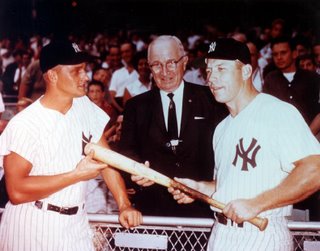 Even Mickey Mantle was known to give up his at bat in certain situations to get the extra run late. His teams were fairly successful if I recall. In the loss we suffered against Minnesota, the error was not Jeter's sacrfice, but the inability of the batters behind him to score the run one way or the other. In general, the only way one can fail with a runner on third and less than 2 outs, is to strike out, pop up, or ground out sharply to third base. Anything else will get you that run. If the runner is on second, you need a hit to score him and nothing short of a hit.
Even Mickey Mantle was known to give up his at bat in certain situations to get the extra run late. His teams were fairly successful if I recall. In the loss we suffered against Minnesota, the error was not Jeter's sacrfice, but the inability of the batters behind him to score the run one way or the other. In general, the only way one can fail with a runner on third and less than 2 outs, is to strike out, pop up, or ground out sharply to third base. Anything else will get you that run. If the runner is on second, you need a hit to score him and nothing short of a hit.
The situation was right for a sac bunt. Jeter handles the bat very well. Damon can run. Sheffield rarely strikes out, and more often than not gets good wood on the ball. Should he somehow fail, A-Rod was the 2005 AL MVP and has a career BPS (avg. + .slg) of about .835 with runners in scoring position. Sheffield's is about .820, compared to Jeter's .709 BPS with RISP. For context, Barry Bonds puts up a .865, Hank Aaron a .864, Willie Mays a .839, and Mickey Mantle a .811.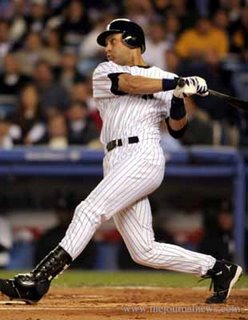 It's not to say that Jeter, with a 3 for 3 night and 3 RBI's, wouldn't have driven Damon home from 2nd forgoing the bunt, but with Mariano Rivera on the mound and a chance to give him an extra cushion, most managers would have made the same choice. Even some of the harshest critics of the Yankees proposed "small ball" approach admit that it was the right thing to do. Look at this highly critical article from Phil Allard of WCBS from early in Spring Training, and tell me the 4th paragraph doesn't apply in some way to what we saw against Minnesota.
It's not to say that Jeter, with a 3 for 3 night and 3 RBI's, wouldn't have driven Damon home from 2nd forgoing the bunt, but with Mariano Rivera on the mound and a chance to give him an extra cushion, most managers would have made the same choice. Even some of the harshest critics of the Yankees proposed "small ball" approach admit that it was the right thing to do. Look at this highly critical article from Phil Allard of WCBS from early in Spring Training, and tell me the 4th paragraph doesn't apply in some way to what we saw against Minnesota.
If you go by Sabermetrics, there is an argument to be made. A runner on second with nobody out has a 63% chance of scoring. A runner on third with 1 out has a 66% chance. In the former situation a team will score an average of 1.19 runs, and the latter situation yields .983 runs after the bunt. Statistically, it appears as though neither strategy yields a clear and decisive outcome. In the first 7 or 8 innings of a ballgame, I think I'd take my chances and swing away. The additional .3 runs that the stats bear out are worth the risk. In the 9th inning, up a run, with Mariano Rivera on the mound, I will 100% support the sacrifice as a strong option. I only want one run, and my chances of getting that run increase by 3%. I'll take it.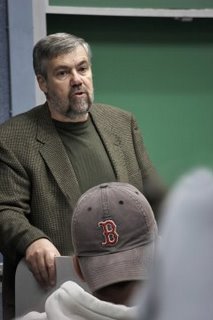 If you read the article I linked to in the 2nd paragraph, you'll see that even Sabermetrics experts fail to completely agree on sacrifice bunting and its value, or lack thereof. Bill James is generally considered one of the fathers of metrics in baseball and he seems to be more open to a situational sacrifice than others. If you scroll down at this link to the situational bunting charts, you'll see that the situation the Yankees were faced with last night was one of the few times that sac bunting is a decent proposition at +0.1%.
If you read the article I linked to in the 2nd paragraph, you'll see that even Sabermetrics experts fail to completely agree on sacrifice bunting and its value, or lack thereof. Bill James is generally considered one of the fathers of metrics in baseball and he seems to be more open to a situational sacrifice than others. If you scroll down at this link to the situational bunting charts, you'll see that the situation the Yankees were faced with last night was one of the few times that sac bunting is a decent proposition at +0.1%.
What it tells us is that sacrifices are generally a big waste. The door that's left open at this point is whether you use it when you're playing for one run late in a game. I say yes, but I may be wrong. You decide for yourself.
It's the lack of quality starts from anyone not named "Randy" or "Mike" that I'm most concerned about. Until we get more of those, the bunting is just intellectual fodder.
Gallos' 24th Straight Clinches Group B
 The daily update continues. Sancti Spiritus demolished Cienfuegos 7-1 to extend their winning streak to 24 consecutive games, and clinch the Group B title. The recent drive toward 27 has featured a number of blowout victories with good pitching and plenty of run production. It will take a dominant pitching performance to even hint at breaking the charge.
The daily update continues. Sancti Spiritus demolished Cienfuegos 7-1 to extend their winning streak to 24 consecutive games, and clinch the Group B title. The recent drive toward 27 has featured a number of blowout victories with good pitching and plenty of run production. It will take a dominant pitching performance to even hint at breaking the charge.
Ramon Licor threw 6 strong innings of one run baseball to keep Cienfuegos at bay. He scattered 6 hits, while walking none and striking out 4 batters. Ismel Jimenez and Danny Perez pitched 3 lights out innings to keep hope alive. 22 of the 27 outs were either strikeouts or stayed in the infield. Licor is now 7-2 with a 4.15 ERA and a WHIP of an alarmingly high 1.588. It seems that whoever steps out there on the mound is producing a top performance, and that's what you need when you are looking to make history.
The big blow of the game was a 3 run triple by first baseman Livan Monteagudo. Reinier Deliano produced a two run homer from the DH slot. What of Yulieski Gourriel, you ask? Young Gourriel finished the day 2-4 with a run and an RBI, and started a 6-4-3 double play. Click below to see his updated stats with 7 games remaining:
 If you double his current stats, you'll have a snapshot of what he'd do in a 162 games season! His current OPS after 82 games in 1.134 which is exactly the same number Mickey Mantle put up in his legendary 1961 season! Up next is the final game with Cienfuegos and then on to play Industriales for the chance to tie and break the record. Good luck hermanos.
If you double his current stats, you'll have a snapshot of what he'd do in a 162 games season! His current OPS after 82 games in 1.134 which is exactly the same number Mickey Mantle put up in his legendary 1961 season! Up next is the final game with Cienfuegos and then on to play Industriales for the chance to tie and break the record. Good luck hermanos.
A Contrast in Styles
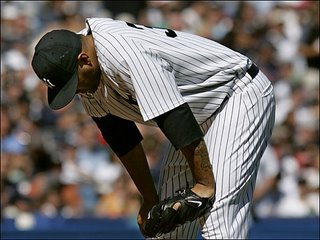 After 10 games the Yankees are 5-5 with all their wins coming in games in which they scored 5 or more runs. That's a lot of 5's. All 5 losses have come in games in which they've scored 4 or fewer runs. On the 2nd day of the season the Yanks dropped a 4-3 game to the A's, when Scott Proctor allowed Marco Scutaro to single in the walk off run in the bottom of the 9th. The Yanks dropped a 4-1 game to the Angels, when Chacon was outpitched by Kelvim Escobar and the Angles pen. The same Angles lineup beat Randy Johnson 3-2, as a combination of Ervin Santana and the dominant relief core allowed two solo homers to Jeter and Matsui, while building their own runs on extended rallies. Johnson pitched a complete game in the loss.
After 10 games the Yankees are 5-5 with all their wins coming in games in which they scored 5 or more runs. That's a lot of 5's. All 5 losses have come in games in which they've scored 4 or fewer runs. On the 2nd day of the season the Yanks dropped a 4-3 game to the A's, when Scott Proctor allowed Marco Scutaro to single in the walk off run in the bottom of the 9th. The Yanks dropped a 4-1 game to the Angels, when Chacon was outpitched by Kelvim Escobar and the Angles pen. The same Angles lineup beat Randy Johnson 3-2, as a combination of Ervin Santana and the dominant relief core allowed two solo homers to Jeter and Matsui, while building their own runs on extended rallies. Johnson pitched a complete game in the loss. Sitting atop the AL East in the early going are the new look Red Sox. At 7-3 the Sox are 3-1 in games in which they score 5 or more runs, but have also posted an impressive 4-2 record in games in which the get fewer than 4. Those wins include a 2-1 win in Texas, 2-1 and 4-1 wins in Baltimore, and today's 2-1 win against the Mariners. Schilling has won two of the Red Sox' 2-1 games, while Beckett and Wakefield posted the other close victories.
Sitting atop the AL East in the early going are the new look Red Sox. At 7-3 the Sox are 3-1 in games in which they score 5 or more runs, but have also posted an impressive 4-2 record in games in which the get fewer than 4. Those wins include a 2-1 win in Texas, 2-1 and 4-1 wins in Baltimore, and today's 2-1 win against the Mariners. Schilling has won two of the Red Sox' 2-1 games, while Beckett and Wakefield posted the other close victories.
The four games that Boston has won, in which they scored 4 or fewer have all followed the same pattern. They are all games in which the starter dominated, giving up only one run, and then turned it over to Timlin and Papelbon. In the Wakefield victory Foulke pitched the 8th, and in today's Schilling effort he gave the ball directly to Papelbon. Another notable game is Beckett's victory against the the Blue Jays in which he gave up 1 run over 7, only to see Foulke allow 2 more in relief. Had Timlin and Papelbon combined in that game, you may have seen a 5-1 win and another dominant game with only 1 run allowed. It still means that in 5 of the 7 Boston wins, their starters only allowed 1 run.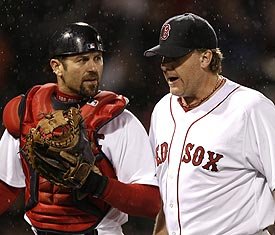 The Yankees can't pin things on Sturtze or the bullpen. Proctor gave up the game in the 9th to the A's, but all the other losses have been credited to the starting pitchers who were not able to shut down the opposition. Chacon has been bad, Wang was bad, and the combination of Johnson and Mussina have been good enough to win with a few extra runs, but they haven't been GREAT. Schilling and Beckett have been GREAT. That's why Papelbon has 5 saves and Mariano has 1. That's why Sox fans are pumped and we are ready to sound the alarm after two weeks of the season.
The Yankees can't pin things on Sturtze or the bullpen. Proctor gave up the game in the 9th to the A's, but all the other losses have been credited to the starting pitchers who were not able to shut down the opposition. Chacon has been bad, Wang was bad, and the combination of Johnson and Mussina have been good enough to win with a few extra runs, but they haven't been GREAT. Schilling and Beckett have been GREAT. That's why Papelbon has 5 saves and Mariano has 1. That's why Sox fans are pumped and we are ready to sound the alarm after two weeks of the season.
What will Beckett, Timlin, and Papelbon do in front of the home crowd against Seattle? Can the Yankees get a decent game out of Jaret Wright against Johan Santana, Francisco Liriano, and Joe Nathan? Pray.
